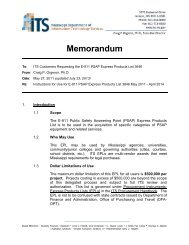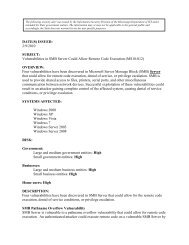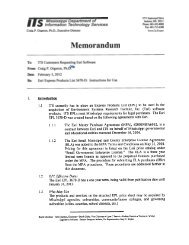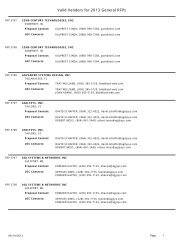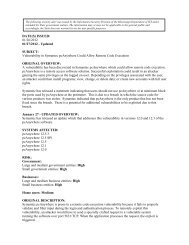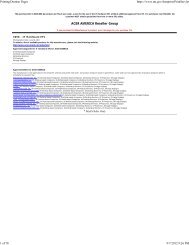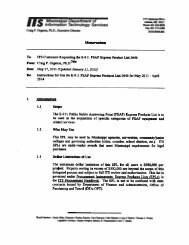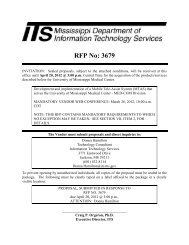Instructions for Use - Mississippi Department of Information ...
Instructions for Use - Mississippi Department of Information ...
Instructions for Use - Mississippi Department of Information ...
Create successful ePaper yourself
Turn your PDF publications into a flip-book with our unique Google optimized e-Paper software.
the Request <strong>for</strong> SOWs must include specifications <strong>for</strong> those factors. The customer must<br />
document each vendor’s score <strong>for</strong> each <strong>of</strong> the evaluative factors as part <strong>of</strong> customer’s purchase<br />
file and include this in<strong>for</strong>mation in the packet submitted to ITS.<br />
• History with Vendor – Agencies may prefer to work with a Vendor who has per<strong>for</strong>med<br />
previous security risk assessments on their networks. The previous knowledge <strong>of</strong> the agency’s<br />
network will reduce the learning curve that would exist with a Vendor who has never<br />
per<strong>for</strong>med an assessment on the network. Alternatively, agencies may prefer to work with a<br />
Vendor who has no previous assessment experience with their networks to involve multiple<br />
perspectives in accessing security risks. Regardless, Vendors who have previously<br />
per<strong>for</strong>med installation, maintenance, and/or support services are precluded from<br />
providing security risk assessment services <strong>for</strong> that agency.<br />
• Quality and Responsiveness <strong>of</strong> the Statement <strong>of</strong> Work - Customers should always give the<br />
Vendor a reasonable response time <strong>of</strong> at least 1 week to provide a Statement <strong>of</strong> Work. The<br />
Statements <strong>of</strong> Work should reflect an understanding <strong>of</strong> the project and a clear explanation <strong>of</strong><br />
the services to be provided.<br />
• Functional/Technical Requirements – Rather than simply providing a list <strong>of</strong> devices to be<br />
scanned and/or quantities <strong>of</strong> other tasks to be per<strong>for</strong>med, customers may wish to outline<br />
specific assessment requirements and require vendors to respond to those requirements in the<br />
SOW.<br />
For assistance with SOWs, please contact Jay White, ITS In<strong>for</strong>mation Security Division, (601)<br />
432-8180, Jay.White@its.ms.gov.<br />
ITS requires that cost be 90 to 100% <strong>of</strong> the score. No more than 10 points may be awarded<br />
<strong>for</strong> non-cost points.<br />
When cost is less than 100% <strong>of</strong> the score, customers must compute the cost score as a ratio <strong>of</strong><br />
the difference between a given proposal's cost and the cost <strong>of</strong> the lowest valid proposal. The<br />
following cost scoring <strong>for</strong>mula should be used <strong>for</strong> every cost evaluation:<br />
Points awarded <strong>for</strong> cost = (1 - [ (B-A)/A ] )*n<br />
Where:<br />
A = Total lifecycle cost <strong>of</strong> lowest valid SOW<br />
B = Total lifecycle cost <strong>of</strong> SOW being scored<br />
n = number <strong>of</strong> points allocated to cost <strong>for</strong> this procurement<br />
In simpler terms, lowest price gets a perfect cost score. A SOW that is 20% more expensive<br />
than the lowest priced SOW gets 20% fewer cost points.<br />
3



